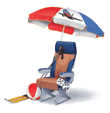How about SRO from O'Hare to Hong Kong?
By Christopher Elliott
New York Times News Service
Published April 25, 2006
The airlines have come up with a new answer to an old question: How many passengers can be squeezed into economy class?
A lot more, it turns out, especially if an idea still in the early stage should catch on: standing-room-only "seats."
Airbus has been quietly pitching the standing-room-only option to Asian carriers, though none has agreed to it yet. Passengers in the standing section would be propped against a padded backboard, held in place with a harness, according to experts who have seen a proposal.
But short of that option, carriers have been slipping another row or two of seats into coach by using stronger, lighter materials that allow for slimmer seat backs. The thinner seats theoretically could be used to give passengers more legroom but, in practice, the airlines have been keeping the amount of space between rows the same to accommodate additional rows.
The result is an additional six seats on a typical Boeing 737 for a total of 156, and as many as 12 new seats on a Boeing 757 for a total of 200.
The developments result from several factors. Higher fuel costs are making it difficult for carriers to turn a profit. The new seat technology alone, when used to add more places for passengers, can add millions in additional annual revenue. The new designs also reduce a seat's weight by up to 15 pounds, helping fuel consumption. A typical seat in economy class now weighs 74 to 82 pounds.
While the airlines are trimming the size of the seat backs in coach, they are installing seats as thick and heavy as ever in first and business class and going to great lengths to promote them. That is because each passenger in such a seat can generate several times the revenue of a coach traveler.

 LinkBack URL
LinkBack URL About LinkBacks
About LinkBacks

 Reply With Quote
Reply With Quote
Bookmarks